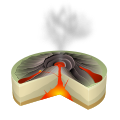歐胡島
| 本条目需要擴充。(2016年12月4日) |
歐胡島 Oʻahu The Gathering Isle(聚集之島) | |
|---|---|
 歐胡島衛星圖 | |
| 地理 | |
 歐胡島在夏威夷州的位置示意圖 | |
| 位置 | 21°28′N 157°59′W / 21.467°N 157.983°W / 21.467; -157.983 |
| 面積 | 596.7 sq mi (1545.3km²) |
| 排名 | 夏威夷群島第三大岛屿 |
| 最高點 | 卡阿拉峰(Mt. Kaʻala) 4,003 ft (1,220米) |
| 人口 | |
| 人口 | 1,000,000(2013年) |
| 密度 | 1,636人/平方英里 |
| 官方標誌[1] | |
| 花朵 | ʻilima |
| 顏色 | Mele Mele(金黃色) |
维基共享资源中相關的多媒體資源:歐胡島(分類) |
瓦胡岛 (夏威夷語:Oʻahu,英语:Oahu,/oʊˈɑːhuː/),又譯為欧胡岛,或被称为“聚集之岛”,是夏威夷群島中面積第三大的島嶼,也是群島中人口最多的島嶼,聚集了夏威夷州总人口的大约三分之二。夏威夷州首府所在地檀香山(又稱為火奴魯魯)坐落于岛屿东南部的海岸边,夏威夷州的空中門戶丹尼爾·井上國際機場也设在瓦胡岛上。如果将福特岛等小面积离岛以及东南方(迎风面)沿岸和卡内奥赫湾内的小岛屿算到一起,则瓦胡岛的总面积1,545.4平方公里(596.7平方英里),成为美国排名第二十大岛屿[2] 。与夏威夷群岛内的其他岛屿一起,瓦胡岛是整个波利尼西亚最靠北端和面积最大的岛屿之一。
瓦胡岛是一个火山岛,按照最远距离计算,它的东西长度为44英里(71公里),南北宽度为30英里(48公里),整个岛屿的海岸线绵延227英里(365公里)。岛上分布着两组相对独立的盾状火山山脉:柯欧劳山脉和怀厄奈山脉。两山之间的谷地,更确切地说应该是两条山脉的鞍部,被称为中央瓦胡平原。瓦胡岛上的最高点位于怀厄奈山脉当中,称为卡阿拉峰(Mt. Kaʻala),其海拔高度为4,003英尺(1,220米)[3]。
目录
1 岛屿概况
2 历史
3 参考资料
4 參考
岛屿概况
瓦胡岛总人口约为976,199人,其中大约72%为本岛常住人口,约81%的人口都生活在岛上被称为“城市”区域的一侧。瓦胡岛长期以来一直被称为聚集之岛(The Gathering Isle)。
历史
1845年,卡美哈梅哈三世将夏威夷王国的首都从毛伊岛迁至本岛。

自空中鳥瞰檀香山市區。

自空中俯瞰珍珠港,位在照片中央的是幾乎被軍事設施佔據的福特島。
遠眺瓦胡岛威基基海灘。
参考资料
^ Fun Facts about Hawaiʻi. State of Hawaiʻi: Office of the Governor. [2007-07-20].
^ Table 5.08 – Land Area of Islands: 2000 (PDF). 2004 State of Hawaii Data Book. State of Hawaii. 2004 [July 23, 2007]. 外部链接存在于|work=(帮助)
^ Table 5.11 – Elevations of Major Summits (PDF). 2004 State of Hawaii Data Book. State of Hawaii. 2004 [July 23, 2007]. 外部链接存在于|work=(帮助)
參考
21°28′N 157°59′W / 21.467°N 157.983°W / 21.467; -157.983
| |||||||||||||||||||||||||
| ||||||||||||||||||||
|

